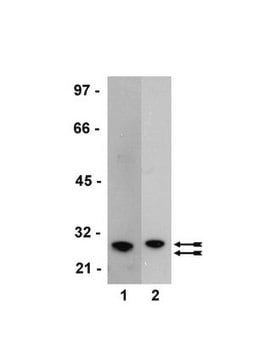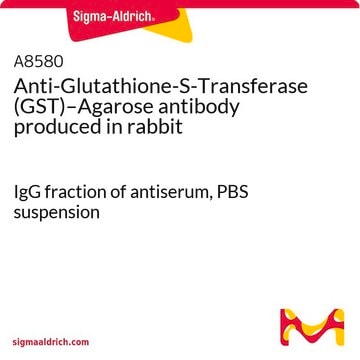Recommended Products
conjugate
unconjugated
antibody form
affinity isolated antibody
antibody product type
primary antibodies
manufacturer/tradename
Cytiva 27-4577-01
packaging
pkg of 0.5 mL, 50 detections
shipped in
wet ice
storage temp.
2-8°C
Related Categories
General description
Application
Features and Benefits
- For the highly sensitive and specific detection of recombinant schistosomal GST fusion proteins expressed using pGEX vectors
- Extensively cross-adsorbed to remove antibodies that bind to E. coli proteins and affinity purified using Glutathione Sepharose™
- Supplied unconjugated for use with any enzyme-conjugated anti-goat antibody
- Recommended for use in Western blots and dot blots to detect GST fusion proteins
Storage and Stability
Analysis Note
Legal Information
A license for commercial use of GST Gene Fusion Vectors under US patent 5,654,176 and equivalent patents and patent applications in other countries must be obtained from Millipore Corp (formerly Chemicon International Inc).
Not finding the right product?
Try our Product Selector Tool.
Storage Class Code
12 - Non Combustible Liquids
Certificates of Analysis (COA)
Search for Certificates of Analysis (COA) by entering the products Lot/Batch Number. Lot and Batch Numbers can be found on a product’s label following the words ‘Lot’ or ‘Batch’.
Already Own This Product?
Find documentation for the products that you have recently purchased in the Document Library.
Customers Also Viewed
Articles
This page describes troubleshooting strategies in the detection of GST-tagged proteins.
Protocols
This page describes chemiluminescence detection of GST-tagged proteins with Amersham ECL, Amersham ECL Prime, and Amersham ECL Select from Cytiva.
Our team of scientists has experience in all areas of research including Life Science, Material Science, Chemical Synthesis, Chromatography, Analytical and many others.
Contact Technical Service












